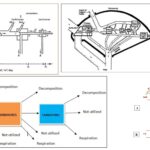IB Biology 35 Views 1 Answers
Sourav PanLv 9November 9, 2024
What are the structures and functions in male and female reproductive systems? (Include in an annotated diagram.)
What are the structures and functions in male and female reproductive systems? (Include in an annotated diagram.)
Please login to save the post
Please login to submit an answer.
Sourav PanLv 9May 15, 2025
The male and female reproductive systems consist of various structures that perform specific functions essential for reproduction. Below is an overview of these structures and their functions, along with an annotated diagram to illustrate the anatomy of both systems.
Male Reproductive System
Structures and Functions:
- Testes:
- Function: Produce sperm and male hormones (primarily testosterone).
- Location: Located in the scrotum, outside the body cavity.
- Epididymis:
- Function: Stores and matures sperm.
- Location: Coiled tube located on the posterior surface of each testis.
- Vas Deferens:
- Function: Transports sperm from the epididymis to the ejaculatory duct.
- Location: A muscular tube that runs from the epididymis to the pelvic cavity.
- Seminal Vesicles:
- Function: Produce a fluid that nourishes sperm and forms a significant portion of semen.
- Location: Located behind the bladder.
- Prostate Gland:
- Function: Secretes a fluid that helps to protect and energize sperm.
- Location: Surrounds the urethra below the bladder.
- Bulbourethral Glands (Cowper’s Glands):
- Function: Produce a lubricating fluid that clears the urethra before ejaculation.
- Location: Located near the base of the penis.
- Penis:
- Function: Delivers sperm into the female reproductive tract; also serves as the organ for urination.
- Location: External structure composed of erectile tissue.
- Scrotum:
- Function: Houses and protects the testes; regulates their temperature.
- Location: Pouch of skin located behind the penis.
Female Reproductive System
Structures and Functions:
- Ovaries:
- Function: Produce eggs (ova) and secrete female hormones (estrogen and progesterone).
- Location: Almond-shaped organs located in the pelvic cavity.
- Fallopian Tubes (Oviducts):
- Function: Transport eggs from the ovaries to the uterus; site of fertilization.
- Location: Extend from the ovaries to the uterus.
- Uterus:
- Function: Houses and nourishes a developing fetus during pregnancy; facilitates childbirth.
- Location: Pear-shaped muscular organ located in the pelvic cavity.
- Endometrium:
- Function: Lining of the uterus that thickens for implantation or sheds during menstruation.
- Location: Inner layer of the uterus.
- Cervix:
- Function: Connects the vagina to the uterus; allows passage for menstrual blood and sperm.
- Location: Lower part of the uterus that opens into the vagina.
- Vagina:
- Function: Passageway for menstrual fluid, receives sperm during intercourse, and serves as birth canal during delivery.
- Location: Muscular tube leading from the external genitals to the cervix.
- External Genitalia (Vulva):
- Includes structures such as:
- Labia Majora and Minora: Protects internal structures.
- Clitoris: Sensitive organ involved in sexual arousal.
- Vestibule: Area containing openings of urethra and vagina.
- Includes structures such as:
0
0 likes
- Share on Facebook
- Share on Twitter
- Share on LinkedIn
0 found this helpful out of 0 votes
Helpful: 0%
Helpful: 0%
Was this page helpful?




